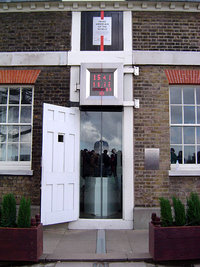Prime Meridian
|
|
The Prime Meridian is the meridian (line of longitude) passing through the Royal Greenwich Observatory, Greenwich, England; it is the meridian at which longitude is 0 degrees. It is sometimes referred to as the Greenwich Meridian.
The meridian was agreed upon in October 1884. At the behest of U.S. President Chester A. Arthur, 41 delegates from 25 nations met in Washington, D.C., USA for the International Meridian Conference.
At the conference the following important principles were established:
- It was desirable to adopt a single world meridian to replace the numerous ones already in existence.
- The meridian passing through the principal transit instrument at the Observatory at Greenwich was to be the "initial meridian".
- That all longitudes would be calculated both east and west from this meridian up to 180?.
- All countries would adopt a universal day.
- The universal day would be a mean solar day, beginning at the mean midnight at Greenwich and counted on a 24-hour clock.
- That nautical and astronomical days everywhere would begin at mean midnight.
- All technical studies to regulate and extend the application of the decimal system to the division of time and space would be supported.
Resolution 2, fixing the meridian at Greenwich, was passed 22-1 (San Domingo, now Dominican Republic, voted against); France and Brazil abstained. The French did not adopt the Greenwich meridian until 1911.
The International Date Line (the jagged red line down the right side of the image to the right) is on the opposite side of the world from the Prime Meridian.
Other reference meridians
The meridian through Greenwich was selected as the Prime Meridian because over two thirds of all ships and tonnage already used it as the reference meridian on their maps in 1884. Other reference meridians used previously include
- Copenhagen
- El Hierro (Ferro) (in the Canary Islands 17° 39' 46" west of Greenwich, or exactly 20? west of Paris)
- Giza
- Jerusalem
- Madrid (3°41′16.48″ west of Greenwich)
- Oslo (Kristiania) (10?43′22.5″ east of Greenwich)
- Paris (2°20′14″ east of Greenwich)
- Philadelphia
- Pisa
- Rome (12°27'08.04" east of Greenwich)
- Saint Petersburg (Pulkovo meridian, 30°19′42.09″ east of Greenwich)
- Washington (77°3′2″ west of Greenwich)
With respect to other solid celestial bodies, prime meridians are likewise arbitrarily defined.
- The prime meridian of Earth's moon lies directly in the middle of the face of the moon visible from earth and passes near the crater Bruce.
- The prime meridian of the planet Mars is defined by the crater Airy-0.


